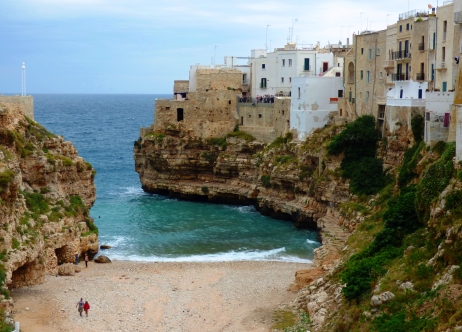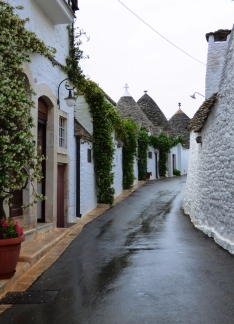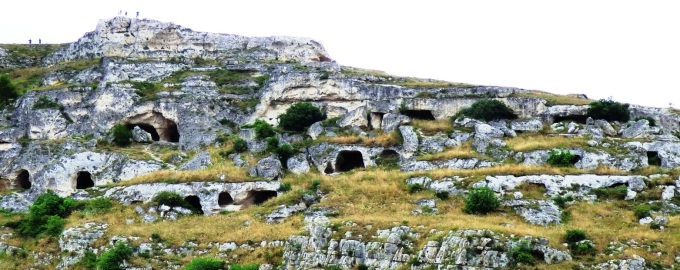Last year, during one of our long weekend getaways, we decided to fly to Bari in Italy and rent a car to drive through the south of Italy (the area right beside the heel of the boot, if you are more visually inclined with maps). As we arrived late in the day on a Friday, we stayed the night in Bari but by Saturday morning got in our rental car to go sightseeing. Saturday was a relaxed day as we only drove to Andria to see a special castle before returning to Bari for the second night of our stay there. But, on Sunday morning we checked out and started a busier day than the last driving to three sites: the seaside at Polignano a Mare, then magical-looking Alberobello (which was further south), thereafter the ancient-looking city of Matera and finally driving back north to end in Foggia where we stayed the night and returned the car the next morning before our flight back to Amsterdam.
I have mentioned this before in another of my articles, but I do feel it is entirely possible to see quite a bit even over just a weekend, especially if you plan your journey before you leave. Certainly, there are those who don’t like to plan and just see where they end up during a trip, which I am sure can be quite surprising, interesting and a true test of one’s traveling mettle. However, I imagine this could also be confusing and tiring for others who are not quite used to traveling and even more so when they are in a foreign environment where language may also be an obstacle. For this reason, I think, more often than not, it is a much better idea to plan ahead and at the very least know where you are going and where you are staying, so that you can enjoy your journey more and pay more attention to where you are and what you are experiencing rather than worry about where to go, what to do or where to stay.

Driving through the beautiful Italian countryside did not disappoint. When we arrived at Castel del Monte in Andria on Saturday morning, I was quite taken by not only the size of the castle, but also by the grand stately impression it made. Its many symmetrical towers as well as the light-colored local stone used to build it made the entire structure really stand out against its bright blue sky backdrop.
Built around 1240 by Emperor Frederick II, this castle built on a hill is quite special and symbolic in that it is not only octagonal in shape, but it also has eight octagonal towers at each of its eight corners. When looked at from above, the symmetry of the castle can truly be appreciated, as I saw a picture of this view and read an information display inside the castle. Castles and palaces were symbolic of this Emperor’s royal power and as a military construction, showed off its defensive, residential and administrative functionality, according to the castle’s informative website. It also stated that the architecture of the castle is a truly unique mix of Northern European Cistercian Gothic, Islamic Orient and classical antiquity styles. The castle is listed as a UNESCO site.

After seeing this impressive castle, we continued on to Polignano a Mare. Settled since prehistoric times, we visited this area mainly to see the gorgeous view of the town set on the cliff and surrounded by the dark blue water of the Adriatic Sea. The view certainly

did not disappoint us as some of the white-washed buildings seem to almost glow in contrast to the dark blue water below and the bright blue sky above.
We took a few photos of the view and each other from the outcropping of rocky land from where the scene could best be viewed. After this, we walked around the town before a light rain hit us and we went back to our car to continue on to the next stop.

As we were arriving in the small town of Alberobello, listed as a UNESCO site, I could already see that there was going to be something special about what we would see next because I had already gotten a few glimpses of some very interesting looking buildings that I saw as we neared our destination. After parking our car, we walked into the town and saw what made the town so special; the trulli of Alberobello.

Located in the south of Puglia, Alberobello’s most impressive sight were the beautiful white-washed trulli (limestone houses) that were built using prehistoric building techniques of mortarless construction. The roofs, which are generally conical or domed, truly made quite a visual impact on us as we approached the town. The buildings looked like life-sized fairy houses to me, especially when we’d see some surrounded by colorful flowers and vines.
The houses, some of which go back as early as the 14th century, are truly wondrous to see and the area boasts 1500 of those structures. In the past, these trulli were built as storehouses, temporary field shelters and permanent homes. Often, the roofs are painted with religious or mythological markings on them using white ash which are meant to protect

the dwellings from bad luck or evil. And, the overall look truly does give the impression of a fairy-tale village. It was simply magical and brought a smile to my face!
After leaving quite happy having seen Alberobello, we drove on to our last destination:

Matera. This UNESCO site encompasses the whole town of Matera, which has been inhabited since the Paleolithic age. With such ancient beginnings, it was no wonder that when we arrived there, it truly felt as if we had gone back in time. The area boasts troglodyte dwellings that have been dug into soft volcanic rock and are essentially caverns.

There are also various churches in the area that have also been carved into the rock. Beside the town, there is a deep ravine that separates the land into two areas. Overall, the entire place felt quite surreal, as it did feel quite ancient. I felt as if I might have somehow accidentally traveled back to a biblical era and might expect to see perhaps one of the twelve disciples coming right out of one of the dwellings!

For this very reason, I imagine, this must be why the area has been used quite often in films to depict biblical period scenes and as an ancient Jerusalem backdrop setting. Some of the most recent films using the area as a location for their films have been Ben-Hur (2016), The Young Messiah (2016), The Nativity Story (2006), Mary (2005), and The Passion of the Christ (2004).
I had fun on this trip that truly yielded many beautiful views to enjoy. Of course, Italy has never failed to impress me every time we have visited it (which has been many times, as there is just so much to see there). Italy is bursting at the seams with things to draw a traveler’s attention in its gorgeous scenery overall, the intricate artwork displayed in paintings, murals and architecture, as well as such deep historical roots tied to the Romans as seen through its ruins scattered throughout the land, and in addition its strong religious ties fostered by the Catholic church via the Vatican and displayed in the innumerable churches and cathedrals throughout Italy. No matter where you go in Italy, trust me – you can’t go wrong!
How lucky you are to be able to pop across to Italy for a long weekend!
LikeLiked by 1 person
Yes, very lucky! Gotta make use of free time whenever you can!
LikeLiked by 1 person
The time it takes you to fly to Italy, we would still be in Australian airspace. 🙂
LikeLike
Well…it is a great advantage to live in Europe…so many countries at your doorstep! Australia is fabulous though, as is nearby New Zealand! You’ve got a lot of beautiful sights near you!
LikeLiked by 1 person
This is true, and I’ll be starting a new Australian series soon.
LikeLiked by 1 person
More stories to look forward to! 😊
LikeLiked by 1 person
Good day, enjoyed reading this. Been here a few times but never left a comment.
Will share this on my Twitter page. Take care
LikeLike
Hi there! I’m so glad you enjoyed the article! Thanks for sharing it! Yes, Italy is quite a lovely country and there is certainly much to see there. Thank you also for visiting my site! I hope to write some new material for my visitors to enjoy soon!
LikeLike